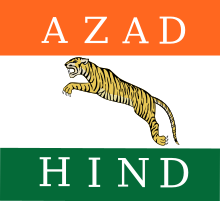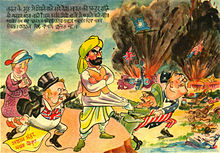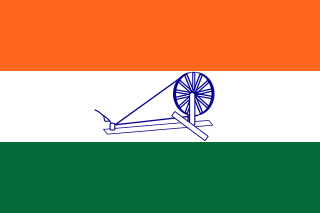
The Indian National Army was an armed force formed by Indian freedom fighters/collaborators and Imperial Japan on 1 September 1942 in Southeast Asia during World War II. Its aim was to secure Indian independence from British rule. It fought alongside Japanese soldiers in the latter's campaign in the Southeast Asian theatre of WWII. The army was first formed in 1942 under Rash Behari Bose by Indian PoWs of the British-Indian Army captured by Japan in the Malayan campaign and at Singapore. This first INA, which had been handed over to Rash Behari Bose, collapsed and was disbanded in December that year after differences between the INA leadership and the Japanese military over its role in Japan's war in Asia. Rash Behari Bose handed over INA to Subhas Chandra Bose. It was revived under the leadership of Subhas Chandra Bose after his arrival in Southeast Asia in 1943. The army was declared to be the army of Bose's Arzi Hukumat-e-Azad Hind. Netaji Subhas Chandra Bose named the brigades/regiments of INA after Gandhi, Nehru, Maulana Azad, and himself. There was also an all-women regiment named after Rani of Jhanshi, Lakshmibai. Under Bose's leadership, the INA drew ex-prisoners and thousands of civilian volunteers from the Indian expatriate population in Malaya and Burma. This second INA fought under the Imperial Japanese Army against the British and Commonwealth forces in the campaigns in Burma: at Imphal and Kohima, and later against the Allied retaking of Burma.

Subhas Chandra Bose was an Indian nationalist whose defiance of British authority in India made him a hero among Indians, but his wartime alliances with Nazi Germany and Imperial Japan left a legacy vexed by authoritarianism, anti-Semitism, and military failure. The honorific Netaji was first applied to Bose in Germany in early 1942—by the Indian soldiers of the Indische Legion and by the German and Indian officials in the Special Bureau for India in Berlin. It is now used throughout India.

The Quit India Movement, also known as the August Kranti Movement, was a movement launched at the Bombay session of the All India Congress Committee by Mahatma Gandhi on 8th August 1942, during World War II, demanding an end to British rule in India.

During the Second World War (1939–1945), India was a part of the British Empire, with the British holding territories in South Asia that included over six hundred autonomous Princely States. India officially declared war on Nazi Germany in September 1939. India, as a part of the Allied Nations, sent over two and a half million soldiers to fight under British command against the Axis powers. India also provided the base for American operations in support of China in the China Burma India Theater.

The Provisional Government of Free India or, more simply, Azad Hind, was an Indian provisional government established in Japanese occupied Singapore during World War II. It was created in October 1943 and supported by – as well as largely dependent on – the Empire of Japan.
Azad Hind Radio was a radio service that was started under the leadership of Subhas Chandra Bose and Adolf Hitler in Nazi Germany in 1942 to encourage Indians to fight for the Axis powers. Though initially based in Nazi Germany, its headquarters were shifted to Japanese occupied Singapore, and later to Hyderabad, following the course of the war in Southeast Asia. After Netaji's departure to Southeast Asia, the German operations were continued by A.C.N. Nambiar, the head of the Indian Legion in Nazi Germany and later ambassador of the Arzi Hukumate Azad Hind in Germany.

Netaji Subhas Chandra Bose: The Forgotten Hero is a 2004 Indian epic biographical war film, written and directed by Shyam Benegal. The film starred an ensemble cast of Sachin Khedekar, Kulbhushan Kharbanda, Rajit Kapur, Arif Zakaria, and Divya Dutta, among others. The film depicts the life of the Indian Independence leader Subhas Chandra Bose in Nazi Germany: 1941–1943, and In Japanese-occupied Asia 1943–1945, and the events leading to the formation of Azad Hind Fauj.

Emilie Schenkl was an Austrian stenographer, secretary and trunk exchange operator. She was the wife or the companion of Subhas Chandra Bose, an Indian nationalist leader.

Sonderreferat Indien, variously translated into English as, Special Bureau for India, Special India Bureau, or Section for Indian Affairs, was a section or bureau established within the Information Department of the Foreign Office of Nazi Germany in late spring 1941 in response to a proposal or memorandum written by the Indian nationalist Subhas Chandra Bose, who had arrived in Germany in early April of that year. The main function of the bureau was to aid Bose in his work, to liaise with Bose, and to mobilize an Indian Legion, comprising Indian POWs captured by Erwin Rommel's Afrika Korps, to aid the German military in a future land invasion of India. A military intervention in India, one of the two major points in Bose's proposal, had at first received a lukewarm response from the German Foreign Minister Joachim von Ribbentrop, but shortly afterwards it received the unexpected support of Adolf Hitler, who saw the battle for India as the natural aftermath of a successful German invasion of Russia and a chance to deliver the ultimate blow to the British Empire.

The Indian Legion, officially the Free India Legion or 950th (Indian) Infantry Regiment, was a military unit raised during the Second World War initially as part of the German Army and later the Waffen-SS from August 1944. Originally intended to serve as a force to fight for independence of British-ruled India, it was made up of Indian prisoners of war and expatriates in Europe. Due to its origins in the Indian independence movement, it was known also as the "Tiger Legion", and the "Azad Hind Fauj". As part of the Waffen-SS it was known as the Indian Volunteer Legion of the Waffen-SS.
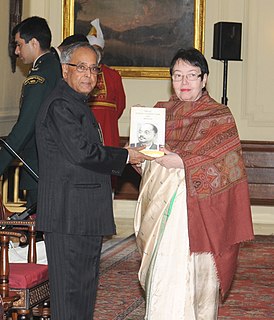
Anita Bose Pfaff is an Austrian-born economist, who has previously been a professor at the University of Augsburg as well as a politician in the Social Democratic Party of Germany. She is the daughter of Indian nationalist Subhas Chandra Bose (1897–1945) and his wife, or companion, Emilie Schenkl.
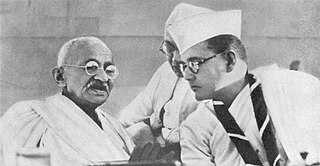
Subhas Chandra Bose 's political views were in support of complete freedom for India with a classless society and state socialism at the earliest, whereas most of the Congress Committee wanted it in phases, through a Dominion status. Even though Bose and Mahatma Gandhi had differing ideologies, the latter called Bose the "Patriot of Patriots" in 1942. Bose admired Mohandas Karamchand Gandhi and called him Bapu, recognising his importance as a symbol of Indian nationalism and giving him political expediency as told by Bose to Rash Behari Bose; called him "The Father of Our Nation" in a radio broadcast from Rangoon in 1944, in which he stated, "I am convinced that if we do desire freedom we must be prepared to wade through blood", a statement somewhat at odds with Gandhi's philosophy of non-violence. Thus, although they shared the goal of an independent India, by 1939 the two had become divided over the strategy to achieve Indian Independence, and to some degree the form which the post-Independence state should take: Gandhi was hostile to industrialisation, while Bose saw it as the only route to making India strong and self-sufficient. Jawaharlal Nehru disagreed with Gandhi on this point as well, though not over the tactics of protest.

The Indian National Army trials was the British Indian trial by court-martial of a number of officers of the Indian National Army (INA) between November 1945 and May 1946, on various charges of treason, torture, murder and abetment to murder, during the Second World War. In total, approximately ten court-martials were held. The first of these was the joint court-martial of Colonel Prem Sahgal, Colonel Gurbaksh Singh Dhillon, and Major-General Shah Nawaz Khan. The three had been officers in the British Indian Army and were taken prisoner in Malaya, Singapore and Burma. They had, like a large number of other troops and officers of the British Indian Army, joined the Indian National Army and later fought in Burma alongside the Japanese military under the Azad Hind.
The First Indian National Army was the Indian National Army as it existed between February and December 1942. It was formed with Japanese aid and support after the Fall of Singapore and consisted of approximately 12,000 of the 40,000 Indian prisoners of war who were captured either during the Malayan campaign or surrendered at Singapore and was led by Rash Behari Bose of Hindu Mahasabha of Japan. It was formally proclaimed in April 1942 and declared the subordinate military wing of the Indian Independence League in June that year. The unit was dissolved in December 1942 after apprehensions of Japanese motives with regards to the INA led to disagreements and distrust between Mohan Singh and INA leadership on one hand, and the League's leadership, most notably Rash Behari Bose, who handed over the Indian National Army to Subhas Chandra Bose but remained as Supreme Advisor to INA. A large number of the INAs initial volunteers, however, later went on to join the INA in its second incarnation under Subhas Chandra Bose.

Mohammad Iqbal Shedai was a British Indian and later Pakistani activist who espoused independence for India and opposition to British colonial policies. He spent most of his life in self-exile in Asian and European countries.
The foreign relations of Third Reich were characterized by the territorial expansionist ambitions of Germany's dictator Adolf Hitler and the promotion of the ideologies of anti-communism and antisemitism within Germany and its conquered territories. The Nazi regime oversaw Germany's rise as a militarist world power from the state of humiliation and disempowerment it had experienced following its defeat in World War I. From the late 1930s to its defeat in 1945, Germany was the most formidable of the Axis powers - a military alliance between Imperial Japan, Fascist Italy, and their allies and puppet states.

Arathil Candeth Narayanan Nambiar was an Indian Nationalist and a friend and colleague of Subhas Chandra Bose. Originally from Kerala, Nambiar spent much of his life serving the Indian independence movement in Europe.

Bhagat Ram Talwar (1908—1983) played an active role in India's freedom struggle. Also known by the alias Silver, he was a freedom fighter and a peasant leader from the North-West Frontier Province in present-day Pakistan. While some authors believe his ancestors were of Punjabi descent, it is known that he was a Hindu Khatri, and identified as a Hindu Pathan.
Leonard Abraham Gordon is a historian of South Asia, especially of Bengal, whose 1990 book Brothers Against the Raj: A Biography of Indian Nationalist Leaders Sarat and Subhas Chandra Bose is considered the definitive biography of Subhas Chandra Bose.
The Indian National Army (INA) was an Indian military wing in Southeast Asia during the World War II, particularly active in Singapore, that was officially formed in April 1942 and disbanded in August 1945. It was formed with the help of the Japanese forces and was made up of roughly about 45 000 Indian prisoner of war (POWs) of British Indian Army, who were captured after the fall of Singapore on 15 February 1942. It was initially formed by Rash Behari Bose who headed it till April 1942 before handing the lead of INA over to Subhas Chandra Bose in 1943.
